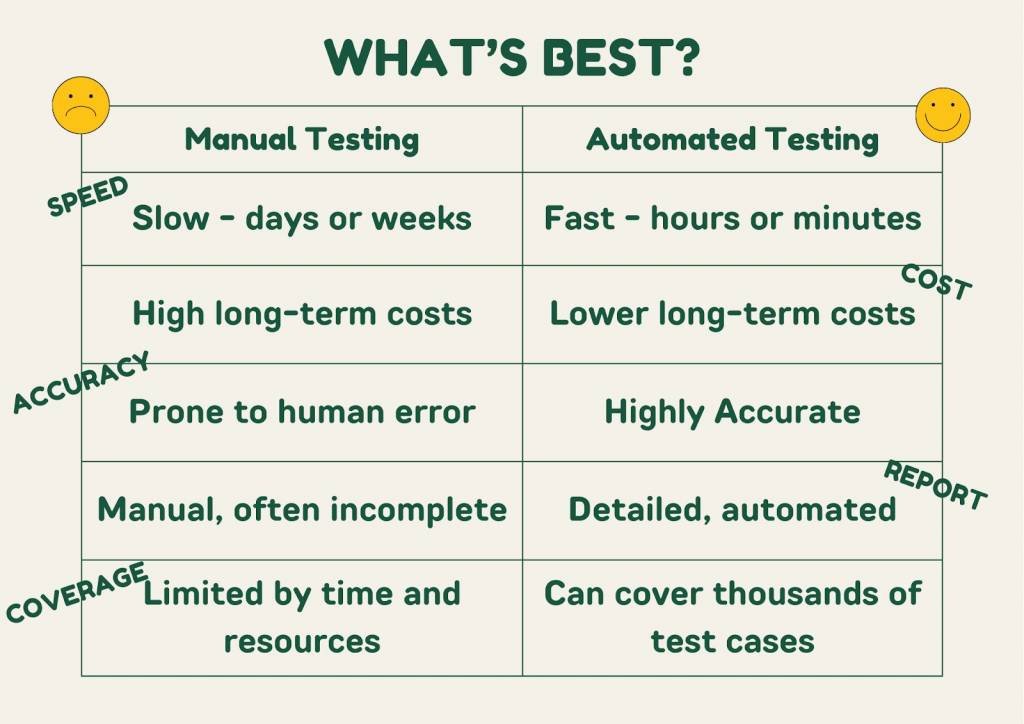5 Reasons to Automate Software Testing

In the race to deliver high-quality software faster, automation isn’t just an option—it’s essential. Are you tired of slow, error-prone testing? It's time to let automation accelerate your software development and deliver top-notch quality more quickly.
Imagine reducing development time, improving accuracy, and saving money—all at once. With automation, you can streamline your workflows, tackle complex scenarios easily, and let your team focus on what matters. Boost efficiency, improve product quality, and stay ahead in the tech world through automation.
As applications grow more complex, traditional manual testing methods often struggle to keep pace. This is where automated software testing comes in, offering a powerful solution. Let's explore the top five reasons why automating your testing processes is not just beneficial, but essential in modern software development.
1. Accelerated Development and Deployment
Speed is crucial in the world of software development. Testing automation tools speed up the development and deployment process, allowing teams to release software more quickly and frequently. These tools reduce testing time from days to hours, enabling teams to release software faster and remain competitive.
They support running tests automatically with each code change to catch issues early and provide immediate feedback. This efficiency accelerates product deployment, helping you reach the market faster, capture opportunities, and respond quickly to user needs.
2. Enhanced Test Coverage
Comprehensive testing is vital for ensuring software quality. The best automation testing tools excel at providing broad and deep test coverage that manual testing often struggles to achieve.
Automation ensures consistent test execution, running the same tests uniformly across different builds and versions. This eliminates the variability introduced by manual testing. At the same time, automation tools make cross-browser and cross-platform testing much easier by easily running checks for compatibility and performance across several browsers and devices.
3. Increased Accuracy and Reliability
Human error is unavoidable in manual testing. Automated testing tools deliver a level of accuracy and reliability that manual processes cannot match. A 2024 survey found that nearly half of data center operators faced severe downtime due to staff not following procedures, and 45% reported serious outages caused by incorrect procedures
Automation minimizes these errors and ensures consistency by executing the same tests each time, which provides reliable results. It also supports early defect detection by running tests frequently, catching bugs earlier in development, and saving time and resources.
4. Cost Efficiency
While the initial investment in automation tools for testing may seem high, the long-term cost savings are substantial.
● Reduces Manual Testing Costs:
Automated testing reduces labor costs through repetitive tasks that are executed quickly and with minimal effort. This, in turn, reduces extensive manual input during the faster testing cycles, thus reducing the overall testing expenses.
● Fewer Post-Release Issues
Automation detects and allows bugs to be fixed when the product is still in development. Early detection lowers support costs post-release and enhances customer satisfaction with more reliable software.
● Resource Optimization
Automating routine tasks frees up time for testers and developers to focus on more challenging and valuable work. This will raise productivity, stimulate innovation, and put available skills in a team to good use.
5. Improved Resource Allocation
Software test automation allows for better allocation of human resources, focusing skilled professionals on tasks that require creativity and critical thinking.
● Focus on High-Value Tasks
By automating routine and repetitive tests, team members can concentrate on more complex testing scenarios, exploratory testing, and strategic quality assurance activities.
● Enhanced Team Productivity
Automation lessens the tedium of manual testing, resulting in increased job satisfaction and productivity among QA professionals.
● Scalability
As projects grow, automated tests can easily scale to meet increased demands without the need for proportional increases in manpower.
Comparison: Manual vs. Automated Testing

Conclusion
Automated software testing offers numerous benefits that truly transform the landscape of software development; it is not just a benefit but a game changer. Now, with the fast-changing technological world and increasing demands for the quality of software, automation is imperative. Thus, automation complements manual testing by accelerating development, enhancing accuracy, and optimizing efficiency.
Embracing automated testing tools is not an option but a strategic necessity for staying ahead in the competitive market. Integrate automation into your testing strategy and enable fast, secure software delivery at the forefront of any digital world today.
Frequently Asked Questions (FAQs)
1. What types of tests can be automated?
Many types of tests can be automated, including:
● Unit tests
● Integration tests
● Functional tests
● Regression tests
● Performance tests
● Load tests
● API tests
However, some types of testing, like exploratory testing or usability testing, still benefit from a manual approach.
2. How long does it take to see the benefits of automated testing?
While the initial setup of automated testing can take time, many organizations start seeing benefits within a few months. The full impact of automation, especially in terms of cost savings and improved quality, often becomes clear within 6-12 months of implementation.
3. Is automated testing suitable for all types of software projects?
While automated testing can benefit most software projects, its suitability can depend on factors like project size, complexity, and development methodology. Small, short-term projects might not see as much benefit from automation as larger, long-term projects. However, even small projects can benefit from automating critical or repetitive tests.
4. How does automated testing impact the role of manual testers?
Automated testing doesn't eliminate the need for manual testers. Instead, it allows testers to focus on more complex, exploratory, and strategic testing tasks. Manual testers often transition into roles that involve creating and maintaining automated tests, as well as analyzing test results, and improving overall test strategies.
5. How do I decide between manual testing and automated testing for my project?
It depends on your needs, based on the project. Manual testing is effective for exploratory and usability/ad-hoc testing, especially during the initial phases of development. Automated testing excels in repetitive, time-consuming tasks like regression testing or big test suites. Automation is necessary in the long term for efficiency and cost savings, mainly in the case when updates happen quite frequently or there are huge test volumes. Balancing manual and automated testing typically yields the best results.
Similar Articles
Consumer interest in fitness apps is rapidly growing, and there is no reason for it to stop. According to Statista, the global fitness application market is expected to grow to $20 billion by 2025, primarily due to growth in the usage of smartphones and customers’ awareness of health.
The real estate industry is quite an intricate web. With its complex transactions and diverse stakeholders, the sector feels an urgent need for reliable and efficient digital solutions. In fact, web apps have become essential tools for businesses operating in this sector
Every business launch is exciting, but it also has its challenges, such as decision-making regarding the selection of proper tools for business processes. It is also a reality that today, no startup can lack software solutions when it comes to business organization and performance.
The education industry is not left behind by the new digital world shift. E-learning has received much consideration with the help of technological factors coupled with the ever-increasing demand for convenience and personalization
Managing a wide range of assets, from IT equipment to digital resources, can be overwhelming without the right tools. Businesses often struggle with asset mismanagement, leading to delays, unexpected costs, and compliance issues.
E-learning has become a quintessential wave through which learners access education in today’s te
Are you tired of keeping up with regulatory requirements and managing risk, which can feel like navigating a labyrinth? Organizations across industries face mounting pressure to maintain compliance while simultaneously driving growth and innovation.
Anyone even vaguely familiar with today's fast-paced digital world would know that e-commerce businesses face intense pressure. Pressure to deliver exceptional customer experiences while also maximizing their profits. To achieve this delicate balance, companies operating in this space must now put the power of technology to work
Intelligent technology-driven solutions are now guiding industries across all sectors. Innovative and disruptive technologies like Artificial Intelligence (AI) and Machine Learning (ML) are driving these changes, which play a crucial role in designing and developing intelligent solutions.









